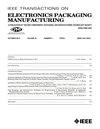Understanding the Correlation Between Intermetallic Growth, Stress Evolution, and Sn Whisker Nucleation
IEEE Transactions on Electronics Packaging Manufacturing
Pub Date : 2010-03-22
DOI:10.1109/TEPM.2010.2043847
引用次数: 48
Abstract
Stress due to intermetallic (IMC) growth is generally accepted as the driving force for Sn whisker formation, but there are still many unanswered questions regarding the development of stress and how it relates to the growth of whiskers. We have made simultaneous measurements of the evolution of stress, IMC volume, and whisker density on samples of different thicknesses to address the underlying mechanisms of whisker formation. Finite-element simulations are used to study the stress evolution due to IMC growth with various stress relaxation mechanisms: plastic deformation coupled with grain boundary diffusion is found to explain observed stress levels, even in the absence of whisker growth. A model of whisker growth suggests that the average steady-state stress is determined primarily by relaxation processes (dislocation- and diffusion-mediated) and that whisker growth is not the primary stress relaxation mechanism. Implications of our results for whisker mitigation strategies are discussed.了解金属间生长、应力演化与锡晶须成核的关系
金属间化合物(IMC)生长引起的应力被普遍认为是锡晶须形成的驱动力,但关于应力的发展及其与晶须生长的关系仍有许多未解之谜。我们同时测量了不同厚度样品的应力、IMC体积和晶须密度的演变,以解决晶须形成的潜在机制。利用有限元模拟研究了IMC生长过程中各种应力松弛机制下的应力演化:发现即使在没有晶须生长的情况下,塑性变形和晶界扩散也可以解释观察到的应力水平。晶须生长的模型表明,平均稳态应力主要由松弛过程(位错和扩散介导)决定,晶须生长不是主要的应力松弛机制。我们的结果对须缓解策略的含义进行了讨论。
本文章由计算机程序翻译,如有差异,请以英文原文为准。
求助全文
约1分钟内获得全文
求助全文

 求助内容:
求助内容: 应助结果提醒方式:
应助结果提醒方式:


